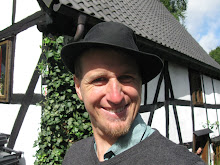For a long time I've been meaning to write about the wildlife here - subtle and cryptic, seasonal, evocative.
When I first came it boggled the mind to have no substantial wilderness around, now the little woods and moors bounded on all sides by development seem normal. Another aspect to the countryside that took getting used to was the smog-haze. Sometimes on a clear day, even in rural areas, a hill one mile away can seem hazy and indistinct. Anything more than 15 miles away can be virtually invisible! It's a combination (an interaction?) between moisture, dust and pollutants. More recently though, I've noticed the variation in this. Some days, especially in summertime, after rain, the atmosphere is as clear as in New Zealand - you can guess I relish those days!
I also relish the seasonal changes here - I caught the end of Autumn in Sussex, with its glory of russet and gold, then the bleak winter in Northumberland, Argyll, Derbyshire and London, when the land lies truly naked. (In most parts of the country, evengreens seem to account for just a few percent of the trees around) I watched the trees dress up again, one by one - beginning with the chestnuts and ending with the limestone-loving ash and the elegant lady: northern beech. Then, to cap it off, the sea of bluebells that rises to lap among the trunks in early May was breathtaking.
I can't put my finger on the particulars, but there seems to be birds around that weren't here in winter - the birds of prey in particular. I should check their migration details out. The kites with their v-shaped tails and the astounding kestrel (you may know G.M.Hopkin's The Windhover) are favourites. The crow family was faithful though, and have stuck around enough for me to identify between jackdaws (gregarious, whitefaced) and ravens (large, curved beaks, mainly solitary). Both were plentiful as I walked the vertigo-inducing path along the clifftops in south-west Cornwall. Crows and rooks are harder to distinguish. Readers' digest tells me rooks appear to wear 'baggy breeches'. Dubious

Jackdaw (Photo by John Haslam- CC Attribution licence)
There are three animals I wouldn't have seen without the aid of keen British wildlife-watchers. Walking along a canal towpath in Derbyshire, an elderly gentleman is staring at something on the other side of the canal. 'It's a grass snake'. Indeed! With the naked eye, it looks like a stick, but we are offered the view through others' binoculars and zoom lenses (by now there is a crowd). It's funny to say this, but, my first impression was... it's got no legs! A brain, a tongue, eyes.... but no legs! Like a fish, but on land. Weird.
Amazingly, it transpires it is not just one grass snake but two. Trying to eat the same toad. Incredible, to watch the drama of these three creatures, maligned in our folklore but beautiful. It is again, a fellow nature junkie who shows me the peregrine falcon chicks, perching on the custom-built nestbox on the spire of Derby Cathedral. They are fledglings, at home in the city centre, with their aggressive curved beak and comical head-bobs.
In Devon, around 10pm, my cousin's neighbour calls up to tell us 'the badger is here'. We head to his kitchen and watch it through the large window. It is out, on the steps, thinner than i imagined, but many times more beautiful. It picks up the bread left out for it nightly, and scoffs a slice in the shadows, before returning again and again for more. I am entranced.


2 comments:
MMm, love this description. Please continue it with a book, I will be an eager buyer of such a book! Was that your first ever snake?
Hey Jewels, thanks for the enthusiasm. I´ve only a little experience with British nature... I´m not sure I have that much to say! but there´ll be a wildlife report #3. And the ´Nature Diary´column in the Guardian Weekly is what inspires me. Read it!
I had seen a snake before, many years ago in Malawi, but it moved away to quickly for me to muse on the weirdness of its body plan.
Post a Comment